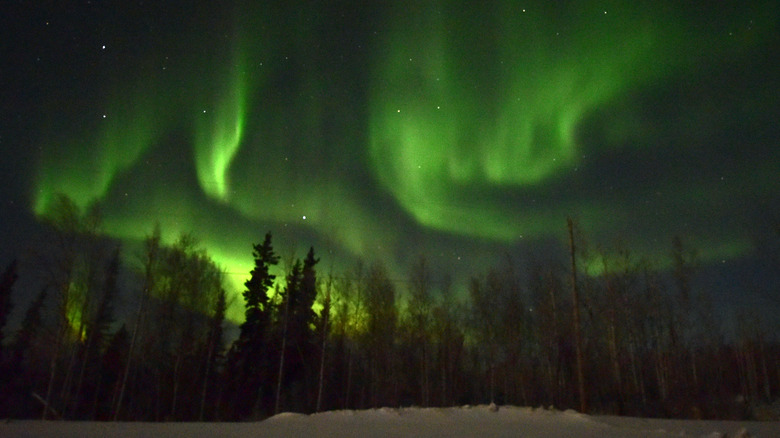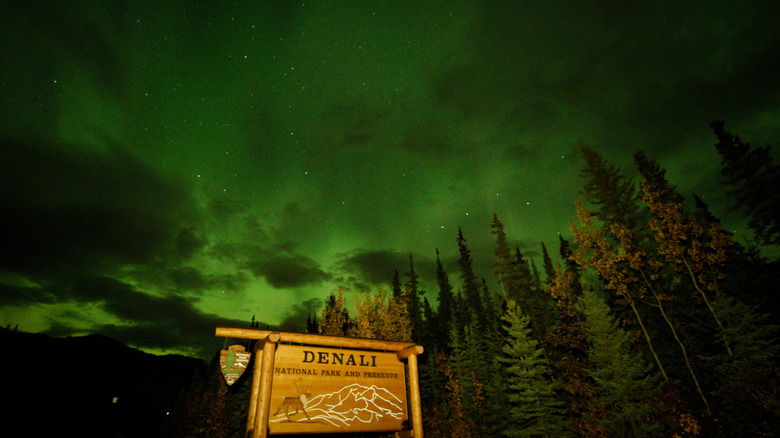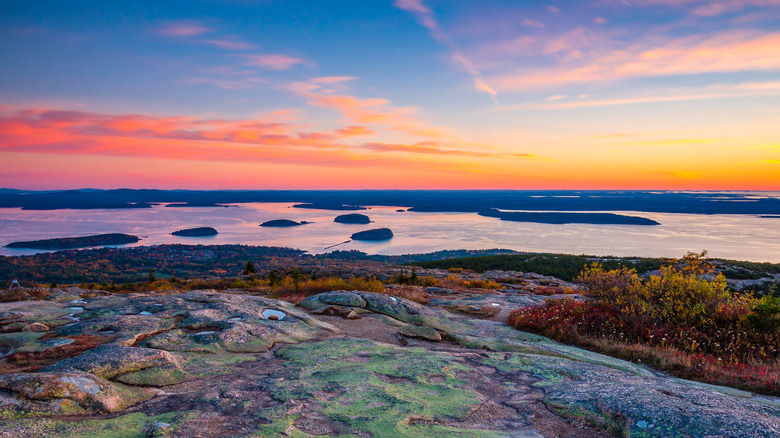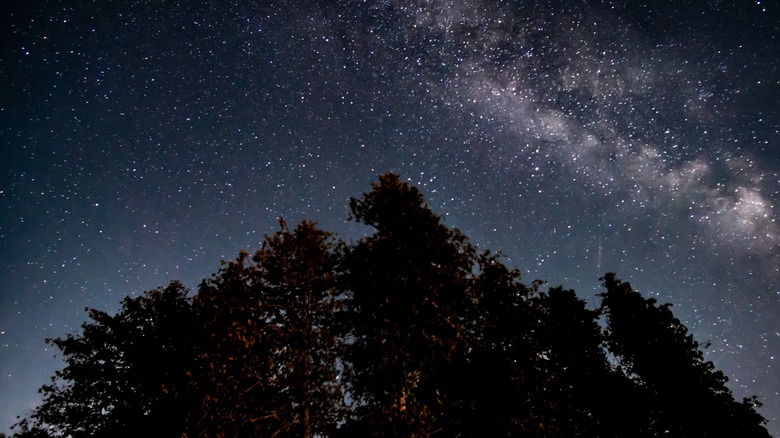The Best Place In The US To See The Northern Lights
Many people dream of seeing the Northern Lights light up the sky in vibrant colors. The Aurora Borealis is the result of solar wind. When the particles from the sun hit the Earth's magnetic field, they are drawn towards the planet's poles. To human eyes, the resulting energy exchange looks like brilliant green lights dancing in the sky. True to their name, the farther north you go the more likely you are to see the Northern Lights. While they may be most common in the Auroral Zone, a circle a little over 1500 miles from the North Pole, checking this fascinating phenomenon off of your bucket list doesn't necessarily mean that you have to go to Svalbard to see it.
In 1859, a massive solar storm made the Northern Lights visible in Honolulu, Hawaii – but unless you're planning to wait for the solar storm of the century, you will probably have to travel farther north than that. According to many travel bloggers, if you want to see the Northern Lights in the United States, your best bet is to go to Alaska.
Alaska is the place to be
Alaska is one of the best places in the world to see the Northern Lights. As travel blogger Martina from Dreaming and Wandering writes, "Alaska's location within 'the zone' means you're almost guaranteed to see spectacular light displays." Exciting! According to Explore Fairbanks, if you go out and look for the Northern Lights between August 21 and April 21 for three nights in a row, you have a 90% chance of seeing the sky light up. The best time to look is on a clear night with no cloud cover, between 10pm and 3am. Aside from clouds, light is your biggest obstacle, so it is vital to choose a date where the moon will not be too bright and to get away from cities and other sources of light pollution.
Around Fairbanks, Alaska, it's extremely common to see the Northern Lights, and one of the best spots in the state to see the Aurora Borealis is a natural space within the city limits: Creamer's Field, a wildlife refuge for migratory waterfowl. It provides wide open spaces and very limited light pollution.
If you're willing to drive about two hours out of the city of Fairbanks, you may want to explore Denali National Park and Preserve. Unlike the vast majority of the United States there is almost no light pollution in the park, making it a perfect site for stargazing or looking for the Aurora.
National Parks across America
While Alaska is undoubtedly the easiest place for people in the United States to see the Northern Lights, there are a few national parks which can provide the opportunity to those hunting for the Aurora Borealis. Isle Royale National Park and Preserve is an island National Park in Michigan that has very little light pollution. As Tiffany Betts of Awesome Mitten explains, "Your best bet to see it here is between mid-April and late October since the park is only open for visiting in warmer months."
The chances of seeing the Aurora Borealis on a typical night in North Dakota's Theodore Roosevelt National Park are slim, but if you know a significant solar event is coming, it could provide the perfect view. Over at National Park Obsessed, travel blogger Jennifer suggests to check the weather forecast, while the optimal times you'd be able to spot the Aurora Borealis are from November to March.
Lastly, Acadia National Park in Maine also doesn't regularly have views of the Northern Lights, but if there happens to be a perfect solar event, a reservation at Cadillac Summit could provide visitors with the view of a lifetime. According to Rob and Allie of Grounded Life Travel, "The sun sets in Acadia in November at around 5:30pm. This gives you over 14 hours of darkness until the sunrises after 7am. That's a lot of time to have fun in the dark."
International Dark Sky Parks and Sanctuaries
Light pollution is the standard in the United States, which means that people wishing to see the Northern Lights, meteor showers, or just stargaze, may have to travel to find a spot where they can get a real look at the night sky. That's what certified Dark-Sky Parks are for. Many parks in the United States have become International Dark Sky Parks and Sanctuaries, dedicated to protecting an environment free from light pollution.
One of these is AMC Maine Woods International Dark Sky Park, which is more than 5400 square miles of wild forest, which promises a view of the night sky that is free from light pollution. Keep an eye on NOAA's solar activity alerts between December and February and consider heading out into the darkness after midnight for a chance to see the Aurora. You might also consider Montana's Glacier National Park, Headlands International Dark Sky Park in Michigan, or Voyageurs National Park in Minnesota.



